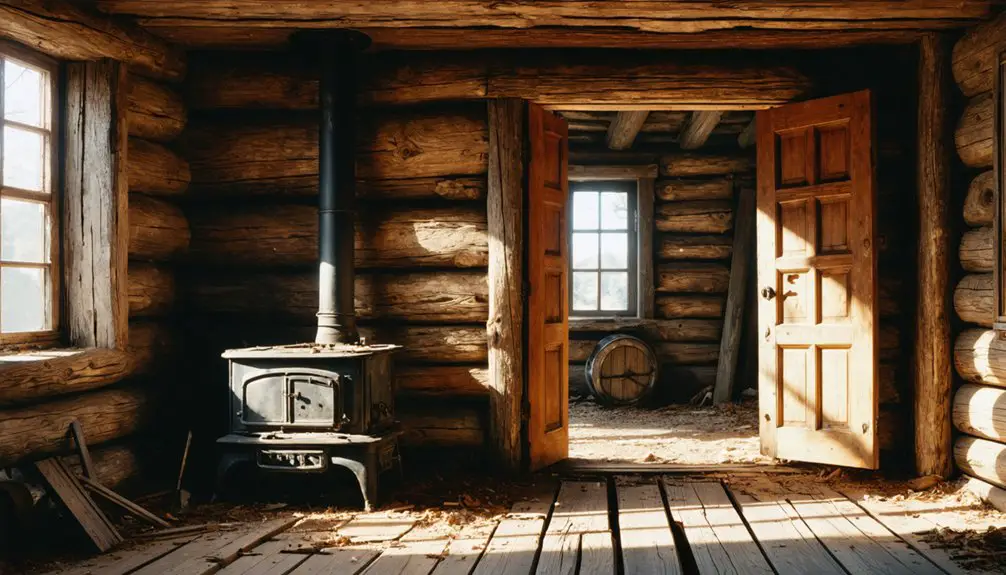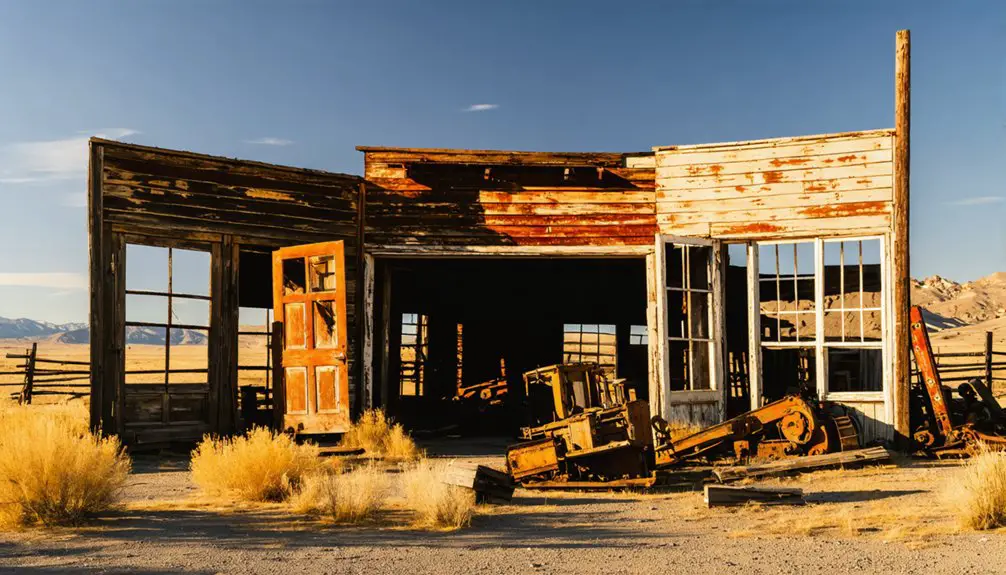You’ll find Hecla’s mining ruins near Upper Crow Creek, where copper operations began in 1879. Named after Iceland’s Hekla volcano, this frontier settlement flourished under the Adams Copper Mining and Reduction Company until the early 1900s. Today, deteriorating foundations and abandoned mine shafts mark where a vibrant community once stood, though private property limits access. The ghost town’s Norse heritage and industrial past hold fascinating tales of Wyoming’s mining era.
Key Takeaways
- Hecla was a copper mining town established in 1879 near Upper Crow Creek, Wyoming, named after Iceland’s Hekla volcano.
- The Adams Copper Mining and Reduction Company developed the site’s first infrastructure, including mills and smelters for copper processing.
- Mining operations declined by the early 1900s due to depleted deposits, with the town’s post office closing in 1929.
- Located near County Road 210 past Curt Gowdy State Park, the ghost town features mining ruins and foundation remnants.
- Access is limited by private property, but visitors can view historic remnants from vehicles during favorable summer road conditions.
The Mining Town’s Norse Connection
The name choice wasn’t random – mining towns often adopted dramatic Norse names to attract attention and investment.
Under the operation of the Calumet and Hecla Mining Company from Michigan, the town’s Norse-inspired identity became part of its cultural significance. The town’s history required internal links to properly document all aspects of its Norse connections.
This connection to Old World narratives and medieval texts gave Hecla a unique mystique that set it apart from other frontier mining settlements. In particular, the name came from Iceland’s volcano Hekla, which was believed to be an entrance to the medieval Netherworld.
Rise of Copper Mining Operations
You’ll find the origins of Hecla’s copper mining operations in 1879, when valuable deposits were discovered along Upper Crow Creek in Wyoming’s Silver Crown Mining District.
The Adams Copper Mining and Reduction Company quickly established the first infrastructure, including a stamping mill powered by wood-fired steam engines to process the ore. The company later expanded operations and developed in 1881 to increase production capacity.
Like other copper mining operations of the era, Hecla’s development was influenced by the industry practices pioneered by Calumet and Hecla Mining Company in Michigan.
Mining Infrastructure Development
During the rise of copper mining operations near Hecla, CK Gold Project emerged as one of America’s few shovel-ready hard rock mines after securing full permits from Wyoming’s Department of Environmental Quality.
You’ll find that mining technology advanced considerably from the site’s historical roots, where stamping mills and basic smelters once stood. The project tackled infrastructure challenges head-on by leveraging its prime location just two miles from Interstate 80, with easy access to paved roads, rail transport, water, and power. The project has secured only 14 million shares outstanding, maintaining a tight capital structure for development.
The development plans called for modern millsites, smelters, and processing facilities, building upon Hecla’s mining heritage. The facility will utilize froth flotation processes to create concentrated minerals for off-site refining.
With Cheyenne only 20 miles away, you’ve got access to skilled labor and logistical support, while water supply strategies include industrial water use, municipal purchases, and onsite wells.
Early Investment and Growth
Moving beyond infrastructure needs, copper mining transformed Hecla’s landscape beginning in the 1860s when prospectors discovered rich deposits in Wyoming’s Sierra Madre region.
Early investment surged when Adams Copper Mining and Reduction Company developed the Copper King Mine in 1881, setting the stage for rapid growth.
- The Hecla Copper & Gold Mining and Smelting Company initially controlled 14 claims, including the townsite and processing facilities.
- Corporate mergers reshaped the industry as Hecla joined with Calumet Company to form the powerhouse Calumet and Hecla Mining Company.
- By 1923, the renamed Calumet and Hecla Consolidated Copper Company dominated regional mining.
- Despite modest ore grades averaging 0.02 ounces of gold per ton and 0.2% copper, the operation’s scale made it profitable.
The company’s strategic acquisitions and processing improvements helped maximize copper recovery from these deposits.
Daily Life in a Mountain Mining Community
While life in Hecla revolved primarily around copper mining operations, the community’s daily rhythms extended far beyond the mine shafts and processing facilities. You’d find miners working grueling shifts, extracting low-grade ore containing just 0.02 ounces of gold and 0.2% copper per ton.
The town’s cultural diversity flourished as immigrant families from Finland, Poland, Italy, Ireland, and Slovenia made Hecla their home, bringing their unique traditions and languages to this remote mountain settlement.
Immigrant families wove a vibrant cultural tapestry in Hecla, transforming a remote mining town into a multicultural mountain community.
Despite harsh conditions and isolation, community resilience shone through. You’d see workers operating steam-powered stamping mills, technicians conducting assays, and families adapting to company-controlled housing and services.
While Cornish “captains” supervised operations, the workforce united to overcome the challenges of this demanding mining life, creating a tight-knit community in their mountain home.
Industrial Heritage and Infrastructure
You’ll find Hecla’s industrial heritage centered around its steam-powered stamping mill, where wood-fired engines drove the crushing of low-grade ore containing about 0.02 ounces of gold and 0.2% copper per ton.
The mill complex included ore concentrating facilities, an assay lab, and smelting operations that formed the heart of the full production cycle. The site’s mining operations paralleled Wyoming’s early gold discoveries in the Algonkian formations around South Pass.
Transportation systems and power infrastructure evolved from early timber-framed structures to more durable industrial facilities, reflecting the mining operation’s technological advancement through the early 20th century.
Mining Operations and Equipment
Although Hecla Mining operated numerous claims throughout Wyoming’s Silver Crown Mining District, their core operations centered on fourteen copper extraction sites supported by extensive infrastructure. The company’s mining machinery evolved from the 1860s through the 1960s, with peak production occurring before World War II.
- You’ll find wood-fired steam engines powered the stamping mills, with governors regulating crushing speeds for ideal ore processing.
- The ore grades averaged 0.02 ounces of gold per ton and 0.2% copper, requiring specialized concentration methods.
- You can trace the progression of ore extraction through concentrating plants, leaching facilities, and smelters that refined the metals.
- On-site assay laboratories tested ore composition, while pumps and mechanical equipment supported the day-to-day mining operations, reflecting the industrial practices of the era.
Mill and Smelter Layout
The industrial heart of Hecla centered on its strategically designed mill and smelter complex, which processed the copper ore extracted by the mining operations.
Today, you’ll find mill remnants and smelter foundations scattered across private property, offering glimpses into this once-bustling operation.
The site’s layout maximized efficiency, with massive beehive-shaped charcoal kilns standing 25-30 feet tall near transportation routes.
These kilns, likely numbering four full-sized units plus smaller ones, produced the fuel needed for smelting.
The complex integrated stamping facilities where ore was crushed and processed, alongside maintenance workshops and storage areas.
While sparse ruins remain, you can still trace the basic outlines of these industrial structures, built from local timber, stone, and brick to withstand the demands of continuous copper processing.
The labor-intensive process of charcoal production required workers to carefully monitor conditions and adjust oxygen levels based on smoke patterns.
The town’s 1880s copper mining operations eventually proved unsustainable, leading to its complete abandonment by the early 1900s.
Transportation and Power Systems
Despite being considered for a Union Pacific Railroad stop, Hecla’s transportation infrastructure remained primarily road-based throughout its operational years.
Transportation challenges meant you’d need four-wheel drive vehicles to navigate the rugged county roads connecting to nearby towns and I-80. The town’s industrial operations relied heavily on steam power, with wood-fired engines driving the vital stamping mill and smelting processes. The town maintained operations until post office discontinued in 1929.
- You’ll find the remains of the stamping mill where a sophisticated steam engine with a governor device once regulated power output.
- Wood camps near the mill supplied fuel for the steam-powered operations.
- The road system served as the primary means for transporting mining output.
- Without railroad access, Hecla’s industrial capacity remained limited by transportation constraints.
The Decline and Abandonment
Mining activity in Hecla began declining sharply by the 1960s as depleted copper deposits and falling market prices made operations increasingly unprofitable.
The economic decline accelerated when the Union Pacific Railroad bypassed the town, severely limiting transportation options for ore shipments and essential supplies.
You’ll find that without major commercial investment or diversified industries beyond mining, Hecla couldn’t sustain its workforce or population.
The community abandonment followed a predictable pattern as mines shut down. Families relocated to find work elsewhere, while critical services and businesses closed their doors.
Without the infrastructure to support long-term residency and faced with competition from more accessible mining districts, Hecla’s transformation into a ghost town became inevitable.
Today, you’ll only find deteriorating foundations and remnants of what was once a bustling mining community.
What Remains Today: A Private Ghost Town

Located near County Road 210 past Curt Gowdy State Park, Hecla’s remains now sit quietly on private property, restricting public access to most of its historic sites.
You’ll find this ghost town best viewed from your vehicle during a quick drive-by, especially in summer or early fall when road conditions are favorable.
While historical preservation efforts have maintained some features, here’s what you can still spot today:
- Foundation remnants and mining ruins from the once-bustling settlement
- The abandoned Copper King mine shaft and lateral development structures
- Boulder piles and rock formations preserved for local wildlife habitats
- Stamping and smelting facility remains, though they’re situated on private land
Remember to respect property boundaries while viewing these remnants of Wyoming’s mining heritage.
Frequently Asked Questions
What Was the Total Population of Hecla During Its Peak Mining Years?
Like a bustling beehive in its prime, you’ll find that population fluctuations in this mining community dynamics reached their zenith at 1,500 residents during the peak mining years.
Were There Any Major Mining Accidents or Disasters Recorded in Hecla?
You’ll find one major historical accident recorded: a hoisting tragedy in 1919 killed five miners and injured three when a cage malfunctioned due to signal confusion from the engineer.
How Did Miners and Their Families Get Supplies in This Remote Location?
You’d rely on supply routes managed by mining logistics, using horse-drawn wagons from distant railheads. You could shop at the company store or grow your own food to supplement delivered goods.
What Was the Average Wage for Hecla Miners in the Early 1900S?
You’d earn about $2.50-$2.91 daily as a Hecla miner in the early 1900s, higher than the regional wage comparison of $2.59. Mining conditions influenced pay rates for different roles.
Did Any Notable Outlaws or Historical Figures Ever Visit Hecla?
Like scanning an empty Instagram feed, you won’t find any notable visitors or historical figures documented in Hecla. Historical records don’t show any famous outlaws or prominent people ever visiting this mining town.
References
- https://en.wikipedia.org/wiki/Hecla
- https://www.wikiwand.com/en/articles/Hecla
- https://sites.rootsweb.com/~wytttp/ghosttowns.htm
- http://www.wyomingtalesandtrails.com/hecla.html
- https://www.ckgoldmine.com/site-history
- https://www.mininghistoryassociation.org/Journal/MHJ-v1-1994-Hausel.pdf
- https://en.wikipedia.org/wiki/Calumet_and_Hecla_Mining_Company
- https://wyomingwhispers.com/hecla-wyoming-ghost-town/
- https://cowboystatedaily.com/2022/09/21/new-gold-mine-west-of-cheyenne-could-employ-2600-people-generate-75-million-in-tax-revenue/
- https://www.cruxinvestor.com/posts/inside-us-gold-corps-300m-plan-to-develop-a-permitted-gold—copper-mine-in-america



